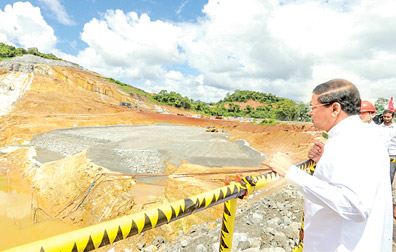|
Moragahakanda-Kaluganga Development Project - over
200,000 farmer families benefit power generation :
Water harnessed
by Lalin Fernandopulle
The development project which had been progressing at a snail’s pace since
its launch in 2007, has been given a turbo boost by the Mahaweli Development and
Environment Ministry, the custodian of the project. The multi purpose
development project is implemented at a cost of approximately US$ 700 million
and is expected to be in operation by 2018
A new feather will be added to the country’s irrigation system admired for
centuries, the world over when treasure objects to commence construction of the
main dam of the Kaluganga reservoir, a part of the Moragahakanda Kaluganga
Development project will be placed by President Maithripala Sirisena tomorrow.
Considered second only to the Mahaweli Development Project, the Moragahakanda
Kaluganga Project is slated to benefit over 200,000 agrarian families and
unleash a host of economic benefits to accelerate development in the country.
The capacity of the two reservoirs account for around 48 percent of the Mahaweli,
Victoria, Randenigala and Rantambe reservoirs put together, and is six times
larger than the Parakrama Samudraya, a brainchild of the legendary king
Parakramabahu I who made a tremendous contribution to the irrigation system in
the country.
Multi purpose
The capacity of the reservoir under the Moragahakanda Kaluganga Project is
660,000 acre-feet.The capacity of the Moragahakanda reservoir is 570 cubic
meters, while the capacity of the Kaluganga is 248 cubic meters. The height of
the main dam of Moragakanda is 61.3 meters and its length, 470 meters.
 |
|
President Maithripala
Sirisena inspects work at the Moragahakanda Kaluganga project |
Centering on the Abanganga and Kaluganga slopes, the Moragahakanda Kaluganga
development project is located in the Naula and Laggala area in the Palegama
Divisional Secretariat in the Matale district.
The development project which had been progressing at a snail’s pace since its
launch in 2007, has been given a turbo boost by the Mahaweli Development and
Environment Ministry, the custodian of the project. The multi purpose
development project is implemented at a cost of approximately US$ 700 million
and is expected to be in operation by 2018.
Mahaweli Development and Environment Ministry Secretary, Udaya R. Seneviratne
said, filling of water to the Moragahakanda reservoir will take place in
November this year. A project funded by the Asian Development Bank to link the
two reservoirs by a nine kilometer tunnel and a 24-kilometer underground tunnel
in the Moragahakanda Uruluwewa area, to avert any harm to the Minneriya
sanctuary will be completed by 2020, he said.
“The magnitude reflects the complexity and benefits that could be derived from
the project, the largest integrated development project launched after the
Mahaweli development project. We have sorted out the issues regarding the
resettlement of around 3,000 families with allocation of funds approved up to
December 31 2015”, Seneviratne said.
Resettlement
He said, around 3,000 hectares under the Kaluganaga reservoir project and 2,000
hectares under the Kaudulla reservoir are being prepared for resettlement.
Administrative villages with all infrastructure facilities have been provided
for resettlement in the Matale district and 30 hectares of forest land has been
provided for the resettlement of a few families in Naula.
According to plans, all families evacuated under the Moragahakanda project will
be resettled by the end of this year and the families under the Kaluganga
project will be resettled by mid next year.
The Moragahakanda Kaluganga project will provide water for the Yala and Maha
seasons in the Matale, Anuradhapura and Polonnaruwa districts. The project will
directly benefit around 130,000 families. Huruluwewa, Mahakandarawa, Mihintale
and Kebithigollawa will be irrigated through the 78-kilometer canal that will be
built by the reservoir.
Around 3,000 metric tons of inland fish could be harvested; while 25MW of
electricity will be generated saving Rs. 336 million on fuel per annum through
the project, which will also provide drinking water to the Anuradhapura,
Polonnaruwa and Trincomalee districts.
Impetus for tourism
The project will help preserve the natural beauty of the environment and
stimulate interest for tourism. It is an immense opportunity to develop eco and
agro tourism.
“The vastly rich bio-diversity in the Knuckles Mountain Range in the Matale and
Kandy districts that provide ample scope for wildlife tourism will make the
location a sought after destination”, Seneviratne said.
The impact of floods caused each year to Manampitiya and Somawathi areas will be
minimized by the project. Gem and jewellery, and commodities such as, pepper,
cinnamon, cloves , nutmeg, vegetables and fruits will fetch a high price with
the influx of tourists to the area. It would thereby open opportunities for new
investments. |

